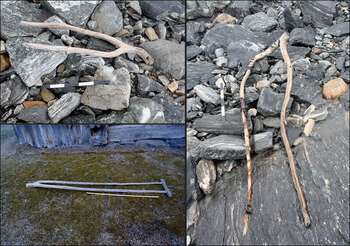Upper left) an object interpreted as a tong (a clamp for holding fodder on a sled or wagon) dated to the Late Roman Iron Age; right) a similar, undated object, also from the pass area; lower left) a historical example from Uppigard Garmo, pre-dating c. 1950 (photographs: Glacier Archaeology Program & R. Marstein). Credit: Antiquity (2020). DOI: 10.15184/aqy.2020.2
A team of researchers from the Innlandet County Council and NTNU University Museum in Norway and the University of Cambridge in the U.K. has found a large quantity of Viking-era artifacts in a long-lost mountain pass in Southern Norway. In their paper published in the journal Antiquity, the group describes the location of the pass, explains why it is suddenly revealing artifacts, and outlines what has been found thus far.
The pass was found back in 2011 on Lomseggen Ridge near a receding patch at Lendbreen glacier. Prior research suggested the reason the artifacts were emerging was because the glacier has been shrinking due to global warming. The team canvased the area over the years 2011 to 2015.
The search resulted in the discovery of a host of artifacts, 60 of which have been dated to between the years 300 AD to 1000. Analysis of the artifacts suggested there were two kinds of travelers through the pass—locals and long-distance trekkers. The researchers suggest locals used the pass to travel between summer and winter homes. Some of the artifacts also suggested that the pass was used mostly during the times when it was covered with snow—the very rocky terrain would have made walking or riding horses difficult. Snow would have smoothed the trail, making traversal less difficult.
The researchers found items such as tunics and mittens, along with horse fittings such as shoes and bits. They also found remnants of sleds, and in one case, the remains of a dog with a collar and leash. Thus far, no human remains have been found in the area and such findings appear unlikely due to the short distance of the pass—it is just 700 meters long.
The researchers also found multiple cairns along the pass—rocks piled in such a way as to provide a guidepost, helping travelers navigate the easiest path through. They even found a small shelter, likely for travelers who found themselves in the midst of a sudden snowstorm.
The researchers suggest the pass fell into disuse as economic conditions changed amid colder winters in the 14th century, and then as the bubonic plague led to restricted travel.
More information: Lars Pilø et al. Crossing the ice: an Iron Age to medieval mountain pass at Lendbreen, Norway, Antiquity (2020). DOI: 10.15184/aqy.2020.2
Journal information: Antiquity
© 2020 Science X Network






















